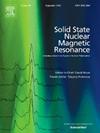固体中快速魔角自旋下单14N-1H交叉极化的自旋动力学和效率
IF 2.4
3区 化学
Q4 CHEMISTRY, PHYSICAL
引用次数: 0
摘要
天然丰富的14N同位素(> 99%)很少用于固态核磁共振(NMR)表征,尽管氮原子在塑造分子结构和性质方面很重要。这种抑制可以归因于大的四极耦合(~几MHz),导致14N核的自旋方法更复杂。实验中,利用自旋1 / 2原子核与14N之间的双向(1H→14N→1H)极化转移,利用自旋1 / 2原子核进行激发和探测。本研究表明,直接14N自旋激发后进行14N→1H交叉极化(CP)是一种有效的极化转移方法,即使对于具有较大四极耦合常数(3-4 MHz)的14N自旋也是如此。这与先前的研究形成了对比,这些研究表明,只有用一对至少一个转子周期长的对称14N脉冲才能观察到1H-14N光谱(J. Chem。物理学报,151(2019):154202)。在实验中建立了14N→1H CP的自旋动力学,如果在四极振动框架中可视化,可以用自旋- 1 / 2 Hartmann-Hahn CP的类比来解释。14N→1H CP的极化转移效率是其他14N编辑实验的1.9 ~ 2.7倍。考虑到与质子相比,14N T1弛豫时间更短,使用14N→1H CP记录14N编辑光谱,从而提高了单位时间的灵敏度。本文章由计算机程序翻译,如有差异,请以英文原文为准。

Spin-dynamics and efficiency of single 14N-1H cross-polarization at fast magic angle spinning in solids
The naturally abundant 14N isotope (>99 %) is sparingly employed for characterization in solid-state nuclear magnetic resonance (NMR) despite the importance of nitrogen atoms in shaping molecular structures and properties. This inhibition can be attributed to large quadrupolar couplings (∼several MHz), resulting in more involved spin methodologies for 14N nuclei. Experimentally, spin-½ nuclei are utilized for excitation and detection through two-way (1H→14N→1H) polarization transfer between spin-½ nuclei and 14N. Herein, we show direct 14N spin excitation followed by 14N→1H cross-polarization (CP) is an efficient method for polarization transfer even for 14N spins with a large quadrupolar coupling constant (3–4 MHz). This contrasts previous studies, which indicate that 1H-14N spectra can only be observed with a pair of at least a rotor period-long symmetric 14N pulses (J. Chem. Phys. 151 (2019) 154202). The 14N→1H CP spin dynamics have been experimentally established and can be explained in analogy to spin-½ Hartmann-Hahn CP if visualized in the quadrupolar jolting frame. The 14N→1H CP is ∼1.9–2.7 times more efficient in polarization transfer than other 14N edited experiments. Considering shorter 14N T1 relaxation times compared to protons, 14N edited spectra were recorded using 14N→1H CP, resulting in enhanced sensitivity per unit of time.
求助全文
通过发布文献求助,成功后即可免费获取论文全文。
去求助
来源期刊
CiteScore
5.30
自引率
9.40%
发文量
42
审稿时长
72 days
期刊介绍:
The journal Solid State Nuclear Magnetic Resonance publishes original manuscripts of high scientific quality dealing with all experimental and theoretical aspects of solid state NMR. This includes advances in instrumentation, development of new experimental techniques and methodology, new theoretical insights, new data processing and simulation methods, and original applications of established or novel methods to scientific problems.

 求助内容:
求助内容: 应助结果提醒方式:
应助结果提醒方式:


